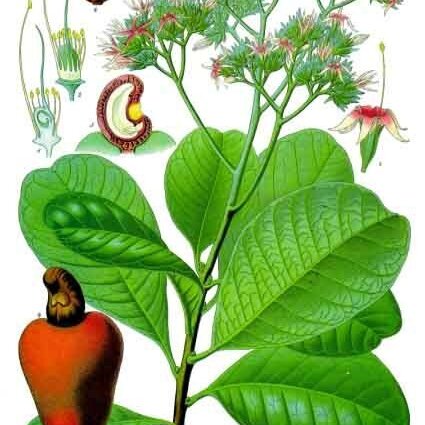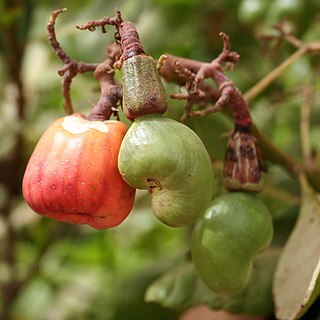Trees or shrubs, evergreen. Leaves short-petiolate; blades simple, entire, coriace-ous. Poarnicles large, terminal. Flowers small, a, bracteate, the pedicels accrescent in fruit; calyx 5-parted, the segments imbricate in bud; petals 5, recurved, imbricate in bud; stamens (7-) 10(-12), unequal, all or a few or only 1 fertile, the filaments basally connate and adnate to the torus; disc or nectariferous outgrowths lacking; ovary subglobose to turbinate or obovate, somewhat gibbous, 1-celled, 1-ovulate, the ovule lateral, ascending on a very short funicle, the style compressed-conic, excentric, as long or slightly longer than the ovary. Nut rather large, reniform, laterally compressed, virtually filled by the solitary reniform seed, borne at the apex of a fleshy hypocarp (the accrescent pedicel).
Shrubs or trees. Leaves alternate, simple, sessile or petiolate, generally oblong-obovate, entire, coriaceous. Flowers in corymbose terminal or subterminal panicles, poygamo-dioecious. Sepals 5, imbricate, slightly connate at the base. Petals 5, imbricate, eflexed, caducous. Stamens 7–10, l(–2) fertile, the rest sterile (staminodes), unequal in length; filaments connate at the base; anthers dorsifixed. Disk absent. Ovary free, sessile, obovoid or obcordate, unilocular, with the ovule ascendent; style 1, with a capitate stigma. Fruit obliquely reniform, compressed, on the swollen pedicel; mesocarp oleaginous. Seeds reniform with thick cotyledons.
Evergreen trees or shrubs, andro-monoecious with functionally staminate and bisexual flowers in same inflorescence. Leaves petiolate, simple; leaf blade margin entire. Panicle terminal, frondo-bracteate with numerous branches. Calyx 5-parted, cup-shaped with pointed lobes. Petals 5, recurved at anthesis. Stamens 7-10, usually 1(or 2) noticeably larger; filament fused basally; anther broadly ellipsoid. Disk lacking. Ovary obovoid, asymmetrical, 1-locular and 1-ovulate; style 1, lateral, linear. Pedicel enlarging after anthesis into a fleshy hypocarp bearing fruit; fruit a nutlike glabrous drupe with bony endocarp.
Ovary free, sessile, obovoid or obcordate, 1-locular, with the ovule ascendent; style 1, with a capitate stigma.
Stamens 7–10, unequal, 1(2) fertile, the others sterile; filaments connate at the base; anthers dorsifixed.
Leaves alternate, sessile or petiolate, simple, entire, coriaceous, generally oblong-obovate.
Fruit ± obliquely reniform, compressed, on the swollen pedicel; mesocarp oleaginous.
Flowers polygamo-dioecious, in corymbose terminal or subterminal panicles.
Sepals 5, imbricate, slightly connate at the base.
Petals 5, imbricate, reflexed, caducous.
Seeds reniform with thick cotyledons.
Shrubs or trees.
Disk absent.
Pending.


